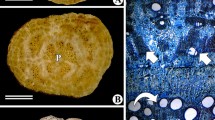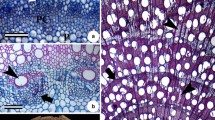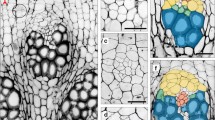Abstract
Hebanthe eriantha (Poir.) Pedersen, a climbing species of the Amaranthaceae increases in stem thickness by forming successive cambia. The family is dominated by herbaceous species and is constantly under discussion due to its disputed nature of the meristem. In the young stem small alternate segments of vascular cambium cease to divide and new arc of cambium initiates outside to it. The newly formed arcs connect with pre-existing alternate segments of cambium to complete the ring. On the contrary, in thick stems, instead of small segments, complete ring of cambium is replaced by new one. These new alternate segments/cambia originate from the parenchyma cells located outside to the phloem produced by previous cambium. Cambium is storied and exclusively composed of fusiform initials while ray cells remain absent at least in the early part of the secondary growth. However, large heterocellular rays are observed in 15-mm diameter stems but their frequency is much lower. In some of the rays, ray cells become meristematic and differentiate into radially arranged xylem and phloem elements. In fully grown plants, stems are composed of several successive rings of secondary xylem alternating with secondary phloem. Secondary xylem is diffuse-porous and composed of vessels, fibres, axial parenchyma while exceptionally large rays are observed only in the outermost regions of thick stems. Vessel diameter increases progressively from the centre towards the periphery of stems. Although the origin of successive cambia and composition of secondary xylem of H. eriantha remains similar to other herbaceous members of Amaranthaceae, the occurrence of relatively wider and thick-walled vessels and large rays in fully grown plants is characteristic to climbing habit.




Similar content being viewed by others
References
Bailey IW (1953) Evolution of tracheary tissues of land plants. Amer J Bot 40:4–8
Balfour ENA (1965) Anomalous secondary thickening in Chenopodiaceae, Nyctaginaceae and Amaranthaceae. Phytomorphol 15:111–122
Barbosa ACF, Pace MR, Witovisk L, Angyalossy V (2010) A new method to obtain good anatomical slides of heterogeneous plant parts. IAWA J 31:372–383
Barghoorn ES Jr (1941) The ontogenetic development and phylogenetic specialization of ray in the xylem of dicotyledons III. Elimination of rays. Bull Torrey Bot Club 68:317–325
Berlyn GP, Miksche JP (1976) Microtechnique and cytochemistry. The Iowa State Univ. Press, Iowa, p 326
Bukatsch F (1972) Bemerkungen zur Doppelfärbung Astrablau-Safranin. Mikrokosmos 61:255
Carlquist S (1991) Anatomy of vine and liana stems: a review and synthesis. In: Putz FE, Mooney HA (eds) The biology of vines. Cambridge University Press, Cambridge, pp 53–71
Carlquist S (1996) Wood, bark and stem anatomy of Gnetales: a summary. International J Plant Sci 157:S58–S76
Carlquist S (1999) Wood and stem anatomy of Stegnosperma (Caryophyllales); phylogenetic relationships; nature of lateral meristems and successive cambial activity. IAWA J 20:149–164
Carlquist S (2001) Comparative wood anatomy: systematic, ecological and evolutionary aspects of dicotyledons wood. Springer, Berlin, p 448
Carlquist S (2003) Wood and stem anatomy of woody Amaranthaceae: ecology, systematics and the problems of defining rays in dicotyledons. Bot J Linn Soc 143:1–19
Carlquist S (2004) Lateral meristem, successive cambia and their products: a reinterpretation based on roots and stems of Nyctaginaceae. Bot J Linn Soc 146:129–143
Carlquist S (2007a) Successive cambia in Aizoaceae: products and process. Bot J Linn Soc 154:141–155
Carlquist S (2007b) Successive cambia revisited: ontogeny, histology, diversity and functional significance. Jour Torrey Bot Soc 134:301–332
Carlquist S (2012) How wood evolves: a new synthesis. Botany 90:901–940
Carlquist S, Hanson MA (1991) Wood and stem anatomy of Convolvulaceae: a survey. Aliso 13:51–94
Committee IAWA (1989) IAWA list of microscopic features for hardwood identification. IAWA Bull n s 10:219–332
De Bary A (1884) Comparative wood anatomy of the vegetative organs of phanerogams and ferns (English translation by Bower FO, Scott DH). Clarendon Press, Oxford, pp 567–614
DeMason DA (1983) The primary thickening meristem: definition and function in monocotyledons. Amer J Bot 70:955–962
Dobbins DR, Fisher JB (1986) Wound responses in girdled stems of lianas. Bot Gaz 147:78–289
Fahn A, Leshem B (1963) Wood fibres with living protoplast. New Phytol 62:91–98
Fisher JB, Ewers FW (1989) Wound healing in stems of lianas after twisting and girdling injuries. Bot Gaz 150:251–265
Fisher JB, Ewers FW (1991) Structural responses to stem injury in vines. In: Putz FE, Mooney HA (eds) The biology of vines. Cambridge University Press, Cambridge, pp 99–124
Fisher JB, Marler TE (2006) Eccentric growth but no compression wood in horizontal stem of Cycas micronesica (Cycadales). IAWA J 27:377–382
Franklin GL (1945) Preparation of thin sections of synthetic resins and wood-resin composites, and a new macerating method for wood. Nature 155:51
Freitas CS, Paula MFR, Rieck L, Marques MCA (2003) Actions of crude hydroalcoholic extract of Pfaffia sp. on gastrointestinal tract. Brazilian Arch Biol and Technol 46:355–360
Grosso MA (2007) Crecimiento secundario inusual en raíz principal de Pfaffia gnaphaloides (L. Fil.) Mart. (Amaranthaceae). Acta Bot Bras 21:21–26
Heklau H, Gasson P, Schweingruber F, Baas P (2012) Wood anatomy of Chenopodiaceae (Amaranthaceae s.l.). IAWA J 33:305–332
Isnard S, Silk WK (2009) Moving with climbing plants from Charles Darwin’s time into the 21st century. Amer Jour Bot 96:1205–1221
Joshi AC (1937) Some salient points in the evolution of the secondary vascular cylinder of Amaranthaceae and Chenopodiaceae. Amer J Bot 24:3–9
Kagiki F, Goncalves G, Oliveira E, Crocomo O, Gallo L (2004) Indução de calos e produção de saponinas totais em Pfaffia glomerata (Spreng.) Pedersen invitro. Rev Bras de Plantas Med 7:43–50
Kraus JE, Arduim M (1997) Manual básico de métodos em morfologia vegetal. Editora EDUR, Rio de Janeiro
Kribs DA (1935) Salient lines of structural specialization in the wood rays of dicotyledons. Bot Gaz 96:547–557
Lev-Yadun S, Aloni R (1991) Polycentric vascular rays in Suaeda monoica and the control of ray initiation and spacing. Trees 5:22–25
Mao TL (1933) Etude comparative des caracteres anatomiques et du parcous des faisceaux libero-ligneux des Chenopodiacees et des Amarantacees. Ph.D. Thesis, Paris
Marchioretto, M.S. 2012. Hebanthe in Lista de Espécies da Flora do Brasil. Jardim Botânico do Rio de Janeiro. (http://floradobrasil.jbrj.gov.br/2012/FB004321)
Menezes NL, Silva DC, Arruda RCO, Melodepinna GF, Cardoso VA, Castro NM, Scatena VL, Scremindias E (2005) Meristematic activity of the endodermis and the pericycle in the primary thickening in monocotyledons. Considerations on the “PTM”. Anals da Academia Brasileira de Ciências 77:259–274
Metcalfe CR, Chalk L (1950) Anatomy of dicotyledons. Clarendon Press, Oxford
Neto A, Costa J, Belati C, Vinholis A, Possebom L, Da Silva Filho A, Cunha W, Carvalho J, Bastos J, Silva M (2005) Analgesic and anti-inflamatory activity of a crude root extract of Pfaffia glomerata (Spreng) Pedersen. J Ethnopharmaco 96:87–91
Norstog KJ, Nicholls TJ (1997) The biology of the cycads. Cornell University Press, Ithaca
Pfeiffer H (1926) Das abnorme Dickenwachstum. Handbuch der Pflanzenanatomie, vol 9, issue no 2. Borntraeger, Berlin, p 272
Phillipson WR, Ward JM (1965) The ontogeny of the vascular cambium in the stem of seed plants. Biol Rev 40:534–579
Rajput KS (2001) Secondary growth of the stem of Celosia argentia L and Aerva sanguinolenta (L.) Blum (Amaranthaceae). Phyton 41:169–177
Rajput KS (2002) Stem anatomy of Amaranthaceae: rayless nature of xylem. Flora 197:224–232
Rajput KS, Rao KS (137) Structural and development studies on cambial variant in Pupalia lappacea (L.) Juss. (Amaranthaceae). Ann Bot Fennici 36:137–141
Rajput KS, Rao KS (1998) Cambial anatomy and absence of rays in the stem of Boerhaavia diffusa (Nyctaginaceae). Ann Bot Fenn 35:131–135
Rajput KS, Rao KS (1999) Nucleated xylem fibres in some members of Combretaceae. IAWA J 20:79–83
Rajput KS, Rao KS (2000) Secondary growth in the stem of some species Alternanthera and Achyranthes aspera (Amaranthaceae). IAWA J 21:417–424
Rajput KS, Patil VS, Kapadane KK (2009) Structure and development of secondary thickening meristem in Mirabilis jalapa (Nyctaginaceae). Polish Bot J 54:113–121
Rajput KS, Patil VS, Kapadane KK (2010) Development of lateral meristem and pattern of secondary growth in stem and roots of Spinacia oleraceae Linn. (Amaranthaceae). Feddes Repertorium 121:1–10
Rajput KS, Nunes OM, Brandes AFN, Tamaio N (2012) Successive cambia and pattern of secondary growth in the stem of the Neotropical liana Rhynchosia phaseoloides (SW) DC (Fabaceae). Flora 207:607–614
Roeser KR (1972) Die Nadel der Schwarzkiefer-Massenprodukt und Kunstwerk der Natur. Mikrokosmos 61:33–36
Rowe NP, Isnard S, Speck T (2004) Diversity of mechanical architecture in climbing plants: an evolutionary perspective. J Plant Growth Regul 23:108–128
Schinz H (1925) Amaranthaceae. In: Engler A, Prantle DK, Die Natürlichen Pflanzenfamilien, vol 16C. Leipzig
Stevenson DW, Popham RA (1973) Ontogeny of the primary thickening meristem in seedlings of Bougainvillea spectabilis. Amer J Bot 60:1–9
The Plant List (2010) Version 1. Published on the Internet; http://www.theplantlist.org/ (accessed 1st January). Missouri Botanical Gardens and the Royal Botanic Gardens, Kew
Vigo C, Narita E, Milanese-Guterre M, Marques L (2004) Caracterizacão farmacognóstica comparativa de Pfaffia glomerata (Spreng.) Pedersen e Hebanthe paniculata Martius—Amaranthaceae. Rev Bras de Plantas Med 6:7–19
Yarrow GL, Popham RA (1981) The ontogeny of primary thickening meristem of Atriplex hortensis (Chenopodiaceae). Amer J Bot 86:1042–1049
Acknowledgments
One of the authors (KSR) is grateful to CAPES-PVE for the financial assistant under Visiting Professor Fellowship in Brazil and to CNPq for grants to Marcati C. R. (Proc. 301352/2008-9-Researcher Grants). Authors are also thankful to both the anonymous reviewers and Prof. Louis P. Ronse De Craene (Associate Editor) for their valuable suggestions.
Author information
Authors and Affiliations
Corresponding author
Rights and permissions
About this article
Cite this article
Rajput, K.S., Marcati, C.R. Stem anatomy and development of successive cambia in Hebanthe eriantha (Poir.) Pedersen: a neotropical climbing species of the Amaranthaceae. Plant Syst Evol 299, 1449–1459 (2013). https://doi.org/10.1007/s00606-013-0807-9
Received:
Accepted:
Published:
Issue Date:
DOI: https://doi.org/10.1007/s00606-013-0807-9




